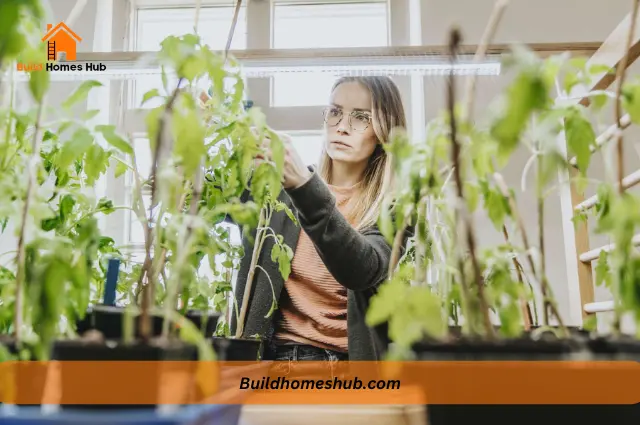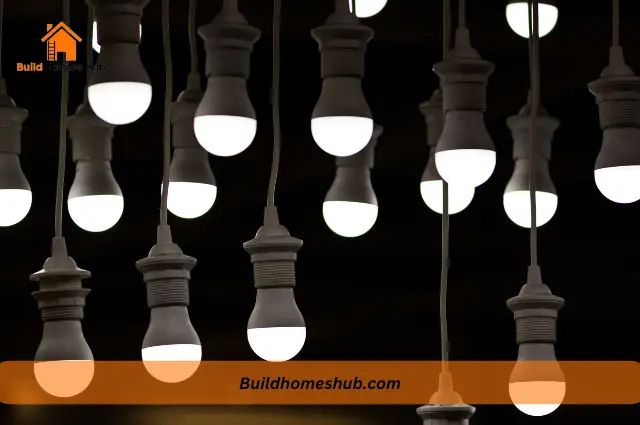Indoor plants bring a touch of nature into your home, serving both decorative and health benefits. However, one of the most common concerns for indoor gardeners is ensuring their plants get adequate light, particularly in spaces with limited natural sunlight. One may wonder: Can the existing ceiling lights serve the purpose?
In this article, we explore the question, “Do ceiling lights help plants?” We’ll dive into the specifics of indoor lighting, the needs of plants, and how different types of artificial lights can impact plant growth and health.
Do Ceiling Lights Help Plants?
Yes, ceiling lights can indeed help plants grow under certain conditions. However, it largely depends on the type of light bulb being used and the specific light requirements of the plant.
Fluorescent bulbs, in particular, can be beneficial for plants as they can provide the necessary light spectrum for photosynthesis. They emit light in the blue and red spectrum, both of which are utilized by plants. Many indoor gardeners use fluorescent lights to successfully grow a variety of plants, including vegetables and flowers, indoors.
LED lights, specifically those designed for plant growth, are also an excellent option for indoor gardening. They can be tailored to emit the perfect spectrum of light for photosynthesis and are energy-efficient, saving you money in the long run.
Keep in mind, though, that most common household ceiling lights, especially incandescent lights, do not provide the ideal spectrum or intensity of light that most plants need to thrive. These can still contribute to plant growth, but they might not be sufficient alone for plants with higher light requirements.
Ways Ceiling Lights Can Help Plants
Houseplants can bring a touch of nature indoors, and their health is a major concern for most homeowners. One crucial element of plant growth is light. Discussed below are how ceiling lights could potentially support plant growth.
1. Provision of Essential Light Energy
Plants rely on light for photosynthesis, the process by which they convert light, water, and carbon dioxide into food. Ceiling lights can provide this necessary light energy, especially in rooms with insufficient natural sunlight.
2. Extended Hours of ‘Daylight’
By utilizing ceiling lights, you can artificially extend the day length, which can be beneficial for plants that require long daylight hours to thrive.
3. Regulated Light Exposure
With ceiling lights, you have control over the light exposure of your plants. This is useful in preventing light-related stress, especially for plants that prefer indirect light.
4. Control over Growth Patterns
Some plants respond to light direction, a phenomenon known as phototropism. Strategically placed ceiling lights can influence the growth direction of such plants, allowing homeowners to guide their growth.
5. Heat Source for Tropical Plants
Certain types of ceiling lights can provide heat in addition to light. For tropical plants that need a warm environment, this dual role of ceiling lights can be beneficial.
The Role of Lighting in Home Aesthetics
As we discuss the symbiosis between indoor plants and lighting, it’s impossible to overlook the enormous impact lighting has on home aesthetics. It plays a pivotal role in setting the mood, highlighting decor, and even influencing the perception of room size. Lighting offers the following roles in home aesthetics:
1. Mood Creation
Different lighting setups can evoke distinct emotional responses. Soft, warm light can create a relaxing and cozy ambiance, while bright, cool light can stimulate focus and energy.
2. Highlighting Decor
Strategically placed lights can draw attention to specific elements in your home, such as artwork, architectural features, or your prized indoor plants. The right light can enhance the beauty of these elements.
3. Perception of Space
The intensity and direction of light can influence the perceived size of a room. Bright, evenly distributed light can make a room feel larger and more open, while dimmer, focused lighting creates a sense of intimacy.
4. Color Enhancement
Light can dramatically affect the appearance of color. Natural daylight reveals the truest color, while artificial lighting can alter how colors are viewed. This is crucial when considering color schemes for rooms and the placement of colorful indoor plants.
5. Enhancing Indoor Plant Aesthetics
Lastly, you can create a dynamic interplay of light and shadow by combining the two elements discussed, indoor plants and lighting. Well-placed lighting can accentuate the unique features of plants, enhancing their contribution to the overall aesthetics of your home.
How to Choose the Right Ceiling Lights for Plant Display
Choosing the right ceiling lights becomes vital when it comes to marrying the need for plant growth with home aesthetics. Here’s a guide to ensure your indoor plants get the light they need while also enhancing your home’s decor:
1. Consider the Light Needs of Your Plants
Different plants have varying light needs. Some need bright, direct light, while others thrive in low, indirect light. Understand the needs of your plants before deciding on a lighting setup.
2. Type of Light
For plant health, full-spectrum lights that mimic natural sunlight are ideal. For home decor, consider the color temperature of the light. Warm light (2000-3000K) creates a cozy ambiance, while cool light (3100-4500K) is bright and invigorating.
3. Intensity and Direction
Light intensity and direction can impact plant growth and room aesthetics. Consider adjustable lights that allow you to change the intensity or direction based on your needs.
4. Use of Timer
Timers can be beneficial to maintain a consistent light schedule for your plants. They also help to automate your lighting aesthetics, creating different moods at different times.
5. Energy Efficiency
Choose energy-efficient lights such as LEDs, which last longer and consume less power. This is especially important if the lights will be on for extended periods to support plant growth.
6. Heat Emission
Lastly, consider the heat emitted by the light fixtures. Some plants might benefit from the additional warmth, but too much heat can harm others or affect the overall comfort of your home. Choose fixtures that balance light output and heat emission.
Benefits of Incorporating Plants Into Home Decor
Plants bring more to the home than just a touch of green. Their incorporation into home decor can yield numerous benefits, some of which include:
1. Enhanced Visual Appeal
Plants add a natural element that can complement almost any decor style, from rustic to modern. They bring color, texture, and life into any room, enhancing its visual appeal.
2. Improved Air Quality
Plants act as natural air purifiers, removing toxins from the air and releasing oxygen. This can improve the overall air quality in your home. Various indoor plants carry out this role.
3. Boosted Mood and Reduced Stress
Studies have shown that indoor plants can boost mood, reduce stress, and even improve concentration and productivity. They create a tranquil and soothing environment that promotes relaxation and well-being.
4. Natural Humidifiers
Plants release moisture into the air through a process called transpiration. This can help maintain optimal humidity levels, especially in dry climates or during winter months when indoor air tends to get dry.
5. Versatility in Decor
From tiny succulents that fit on a bookshelf to towering palms that can fill a corner, there’s an indoor plant suitable for every space and decor style. This versatility allows for endless possibilities in home decor.
My Recommendations for Indoor Grow Lights
1. FRGROW LED Grow Light
The FRGROW LED Grow Light is a game-changer for indoor gardening enthusiasts. With its dimmable feature and 1500W full spectrum coverage, it mimics natural sunlight, providing plants with UV and IR light for optimal growth. The lamp, fitted with 584 LEDs, emits uniform light that reaches even large plants.
A standout feature is the Daisy Chain Function, which allows you to connect multiple lights together, ideal for extensive indoor gardens. The active cooling system is also impressive; it efficiently dissipates heat, ensuring a longer lifespan for the LED lights. This grow light is an excellent investment, providing value through its advanced features and reliable performance.
2. SZHLUX Grow Light
SZHLUX’s 2FT 80W Full Spectrum LED Grow Light is another solid choice for indoor gardeners. Its full-spectrum coverage aids in plant growth at all stages. The linkable feature is a boon for customized light setups, allowing you to expand your lighting system as your indoor garden grows.
With an On/Off switch, operating these grow light strips is convenient and user-friendly. The 2-pack offering is an added advantage, making it perfect for those with more significant lighting needs. In terms of performance and flexibility, this grow light ticks all the boxes.
3. Bstrip Hanging Full Spectrum Grow Lights
The Bstrip Hanging Full Spectrum Grow Lights are exceptional for indoor plants. Its 25W bulbs are powerful yet energy-efficient. Emitting 5000K of light, these bulbs provide a balanced, full-spectrum light that promotes healthy growth in plants. The 16.4FT power cord is a thoughtful addition, offering flexibility in positioning the lights.
What sets this light apart is its built-in timer, allowing you to set a regular lighting schedule for your plants. Ideal for gardens, flowers, and other indoor plants, these lights blend functionality with ease of use. Bstrip’s grow light is a high-quality product that does not disappoint.
Conclusion
To sum up, ceiling lights do have a role in supporting plant growth while also playing a pivotal part in home aesthetics. Choosing the right lighting setup can elevate your decor, showcase your indoor plants, and create a warm, welcoming environment. In the dance of light and greenery, both your plants and your interior design can flourish in harmony.
I hope to help you make the right choices with my content. I am passionate about building new homes and renovations. Follow me, on my socials, I drop nice stuff that may be helpful.











